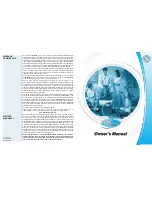
Cleaning with the Steam Nozzle
Cleaning Floors
(Figures 8 and 10)
APPLICATIONS
How to Clean with the Accessories
9
• Cleaning ceramic tile floors, carpets and tiled walls
• Cleaning windows, mirrors, glass cabinets and other glass surfaces
• Removing stains in carpets, furniture, uphostery and clothes
• Removing grease and dirt and sanitizing kitchen units, such as
cupboards, sinks, ovens, refrigerators, tables, etc.
• Cleaning shutters, blinds, corners and angles that are particularly
difficult to reach
• Sanitizing and cleaning sinks, bathtubs, showers, etc.
• Cleaning garden furniture and tools
The rectangular brush is ideal for cleaning floors and walls without the need for
detergents or chemical products. The following are some other Steamax™
uses.
The steam nozzle is for cleaning areas which are difficult to reach. Follow these
steps to use steam to eliminate dirt and germs from corners and angles, cracks
and gaps:
Clip on a clean, absorbent cloth to the rectangle brush (Figure 10).
HINT: For best result, wash and dry cloth prior to its first use after purchase
.
• Press the steam switch to loosen the dirt with the steam jet.
• Remove the dirt with the supplied absorbent floor cloth.
• To eliminate ground-in dirt, we recommend the use of small round brush,
fitted to the steam nozzle.
• Press the steam switch. ( Figure 3)
• Clean the floor without rubbing too hard.
• To clean particularly dirty floors, first use a large brush without the floor cloth
to allow more steam to loosen dirt (no need to apply pressure). Once the dirt
is loosened, fix the clean cloth to the brush and remove the dirt.
• As the cloth picks up dirt, you can flip the cloth over to use the clean size to
minimize dirty cloths.
Important:
The steam from the Steamax™ nozzle reaches a temperature of 220°F at
the tip. When cleaning heat sensitive materials, hold the steam nozzle at
least 4-5 inches from the surface.
Important:
Be particularly careful when cleaning heat-sensitive materials. On
hardwood floors, keep the brush moving at a steady pace. Do not over
wet the surface.
































